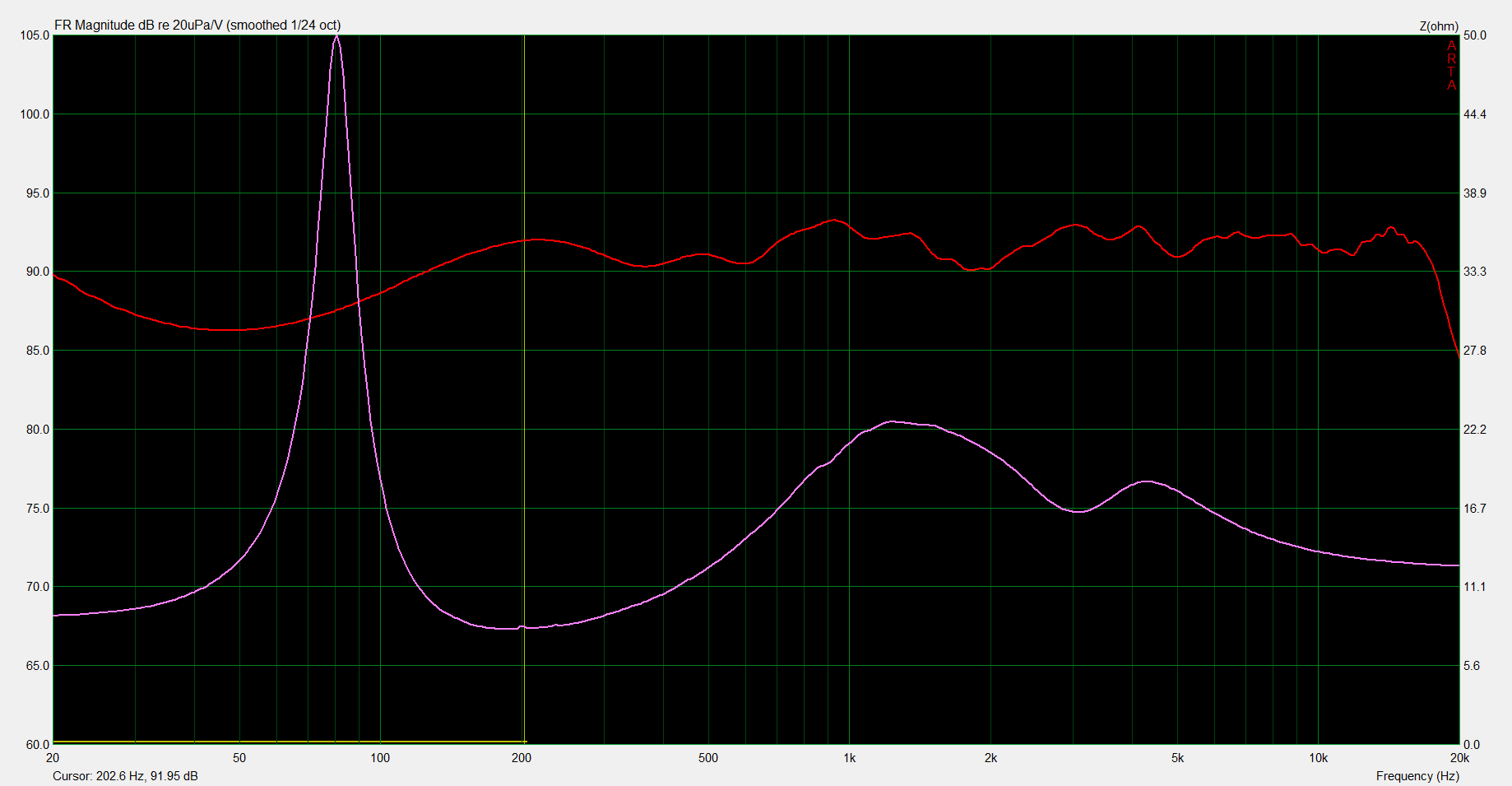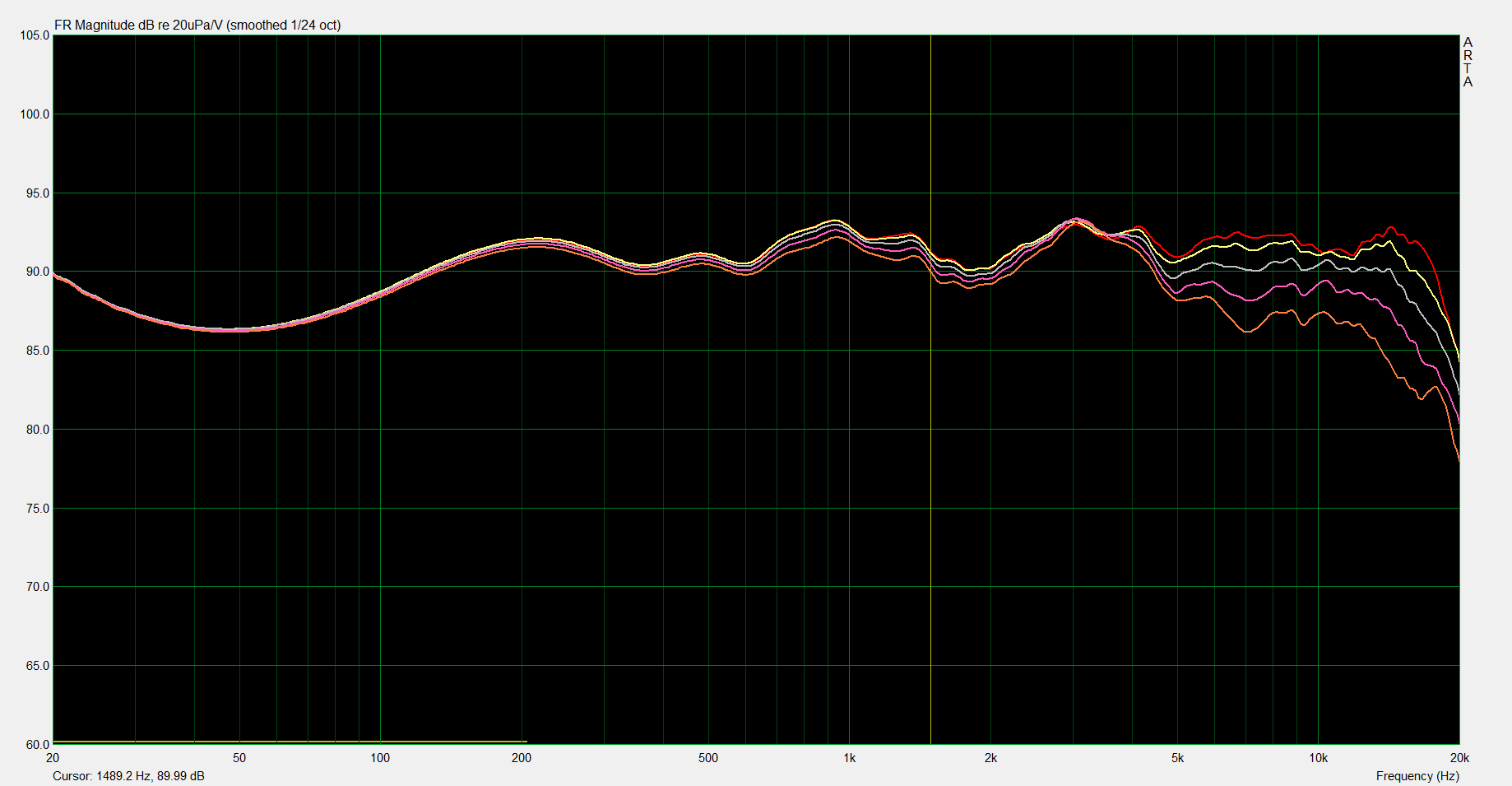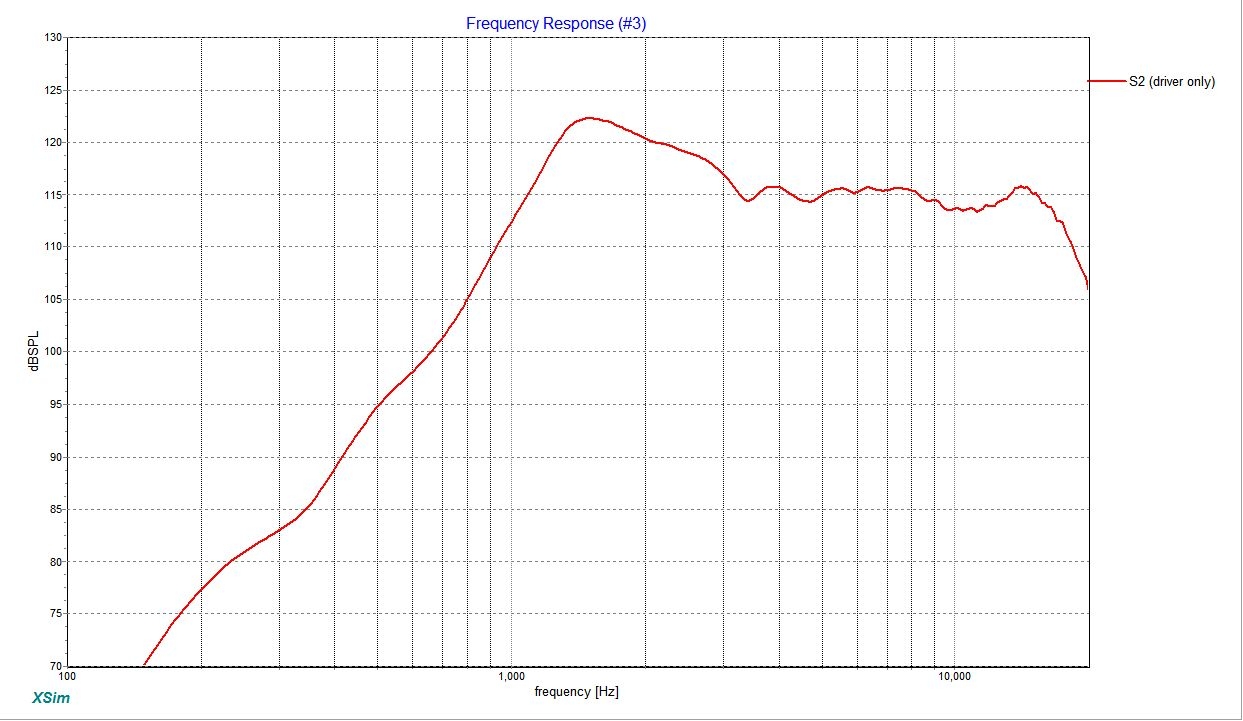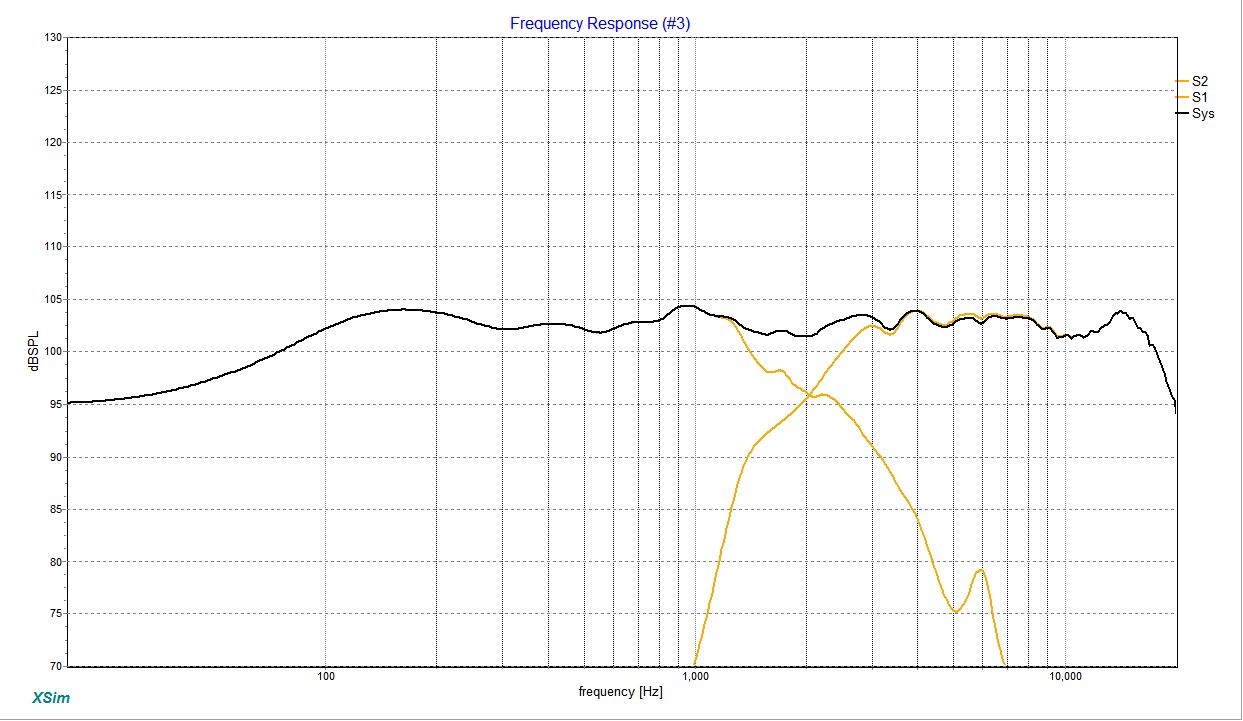Site Links
Howdy, Stranger!
It looks like you're new here. If you want to get involved, click one of these buttons!
Quick Links
Categories
In this Discussion
Please review the site Rules, Terms of Service, and Privacy Policy at your convenience. Rules, TOS, Privacy
Get familiar with the reaction system: Introducing the Reaction System
Sony_Dayton 2-way
I brought this design to Iowa, so thought I would finally throw up some information on it.
This is a pretty straightforward 2-way design using a 5" woofer from a cheap Sony bookshelf. More details on the woofer (as well as some preliminary modeling and an early crossover design) can be found here:
https://diy.midwestaudio.club/discussion/704/midwoofers-from-sony-mb-150h/p1
The woofer was a pleasant surprise given the provenance. Inexpensive commercial bookshelf speakers generally do not use drivers of this quality. Non-stamped frame, plenty of voice coil venting, decent T/S parameters, etc.
The tweeter is the inexpensive Dayton waveguide loaded ND model. I have some thoughts on what Dayton could do to improve this driver, but as-is it is not entirely objectionable.
Enclosure is the Denovi 0.23 flat pack, tweeter flush mounted, woofer surface mounted. I can provide specifics if anyone wants to duplicate this build - but since the drivers are either found as surplus replacement parts or scavenged from a pair of commercial speakers, I'll save the bandwidth.
Crossover is ~2K - this would seem to be low for the Dayton, but as distortion testing shows, not really. In fact, this is overall a fairly low distortion design:

It utilizes ~3db of baffle step (more on that when the bass model is seen), and impedance is definitely amp friendly:

In the image above, I used the modeled impedance and that was taken in a sealed cabinet. Tuning is ~60Hz, with F3/6/10 of 62/53/45Hz. These are approximate, of course. In any event, during playback they sound much fatter than they model. They also exhibit exceptional cone control, and were moving some air at the event.

As you can see, there is a predicted ripple in the response which, I believe, is the reason for the perceived bass performance. It is also why I ended up using less than the "normal" 6db of BSC.
Crossover was reasonably simple with two components on the woofer, and five on the tweeter.

And some horizontals:

Some mild bunching at 3K, but keep in mind I took these quickly - which is why you see drop in output all the way to the gate (200Hz). It is unlikely the woofer is beaming below the crossover point - I would argue if I use my tape measure next time we would see CD behavior up above 2K. Above 2K, the tweeter exhibits excellent off-axis behavior - the wave guide is doing its job.
A little too well, actually. The major issue with this driver is the boost from the horn loading seems to be centered at approximately the same frequency as the tweeters resonance. As many of you know, tweeters sans rear chambers often exhibit a high Q boost in the low end. The waveguide on this really exacerbates it, such that a simple crossover which might lead to some lower order slopes is not possible.
Here is the raw response (with some SPL boost applied for modeling purposes):

In my opinion, it is probably better to look at this particular waveguide application as diffraction control. There are no benefits given the cost of this tweeter to the boosted bottom end. The resonance is so strong and the corresponding peak is of such magnitude that smoothing it out given it is likely to end up being less than 12db down from even a high crossover point that the tweeter quickly becomes fairly expensive. I don't personally give a shit if I spend more on the crossover for a single driver than the rest of the project costs - but it is (and should be) a serious consideration for most people. You have to ask yourself why Dayton has not chambered this otherwise excellent tweeter element? There are plenty of existing designs for them to copycat from, so they would not even really need to spend a lot of time engineering it. With a rear chamber, this tweeter would be exceptional! As it is, be comfortable throwing a lot of components at it or live with the slight edginess from the resonance, or cross it over so high that it ends up being a waste of money and baffle real estate to have gone with the waveguide in the first place. I elected option 2 on this build, although the 3rd order electrical plus split L-pad helps tame the resonance somewhat:

As you can see, even with five components the resonance is still hanging out there. I was able to make it disappear with an LCR notch on it - but even I balked at the added cost and complexity for what amounts to a $12 tweeter. The network to make this work to its full potential means I probably should have went with a different tweeter but we live, we learn. The inexpensive Vifa with the waveguide is simply better.
Anywhoo, if Dayton chambers this tweeter, I will immediately purchase a pair and rework this design.
So anyways, I received some positive feedback on this design. I sold the first pair to a guy here in town who shelved his Elac Debut 6 something or other afterwards so not sure what it means that my design convinced a guy that Mr. Jones does not walk on water but I took it as a compliment.
Here are both drivers after crossover applied:

The model matches reasonably well, close enough for me anyways.
As always, DIY for the sake of DIY!
This is a pretty straightforward 2-way design using a 5" woofer from a cheap Sony bookshelf. More details on the woofer (as well as some preliminary modeling and an early crossover design) can be found here:
https://diy.midwestaudio.club/discussion/704/midwoofers-from-sony-mb-150h/p1
The woofer was a pleasant surprise given the provenance. Inexpensive commercial bookshelf speakers generally do not use drivers of this quality. Non-stamped frame, plenty of voice coil venting, decent T/S parameters, etc.
The tweeter is the inexpensive Dayton waveguide loaded ND model. I have some thoughts on what Dayton could do to improve this driver, but as-is it is not entirely objectionable.
Enclosure is the Denovi 0.23 flat pack, tweeter flush mounted, woofer surface mounted. I can provide specifics if anyone wants to duplicate this build - but since the drivers are either found as surplus replacement parts or scavenged from a pair of commercial speakers, I'll save the bandwidth.
Crossover is ~2K - this would seem to be low for the Dayton, but as distortion testing shows, not really. In fact, this is overall a fairly low distortion design:

It utilizes ~3db of baffle step (more on that when the bass model is seen), and impedance is definitely amp friendly:

In the image above, I used the modeled impedance and that was taken in a sealed cabinet. Tuning is ~60Hz, with F3/6/10 of 62/53/45Hz. These are approximate, of course. In any event, during playback they sound much fatter than they model. They also exhibit exceptional cone control, and were moving some air at the event.

As you can see, there is a predicted ripple in the response which, I believe, is the reason for the perceived bass performance. It is also why I ended up using less than the "normal" 6db of BSC.
Crossover was reasonably simple with two components on the woofer, and five on the tweeter.

And some horizontals:

Some mild bunching at 3K, but keep in mind I took these quickly - which is why you see drop in output all the way to the gate (200Hz). It is unlikely the woofer is beaming below the crossover point - I would argue if I use my tape measure next time we would see CD behavior up above 2K. Above 2K, the tweeter exhibits excellent off-axis behavior - the wave guide is doing its job.
A little too well, actually. The major issue with this driver is the boost from the horn loading seems to be centered at approximately the same frequency as the tweeters resonance. As many of you know, tweeters sans rear chambers often exhibit a high Q boost in the low end. The waveguide on this really exacerbates it, such that a simple crossover which might lead to some lower order slopes is not possible.
Here is the raw response (with some SPL boost applied for modeling purposes):

In my opinion, it is probably better to look at this particular waveguide application as diffraction control. There are no benefits given the cost of this tweeter to the boosted bottom end. The resonance is so strong and the corresponding peak is of such magnitude that smoothing it out given it is likely to end up being less than 12db down from even a high crossover point that the tweeter quickly becomes fairly expensive. I don't personally give a shit if I spend more on the crossover for a single driver than the rest of the project costs - but it is (and should be) a serious consideration for most people. You have to ask yourself why Dayton has not chambered this otherwise excellent tweeter element? There are plenty of existing designs for them to copycat from, so they would not even really need to spend a lot of time engineering it. With a rear chamber, this tweeter would be exceptional! As it is, be comfortable throwing a lot of components at it or live with the slight edginess from the resonance, or cross it over so high that it ends up being a waste of money and baffle real estate to have gone with the waveguide in the first place. I elected option 2 on this build, although the 3rd order electrical plus split L-pad helps tame the resonance somewhat:

As you can see, even with five components the resonance is still hanging out there. I was able to make it disappear with an LCR notch on it - but even I balked at the added cost and complexity for what amounts to a $12 tweeter. The network to make this work to its full potential means I probably should have went with a different tweeter but we live, we learn. The inexpensive Vifa with the waveguide is simply better.
Anywhoo, if Dayton chambers this tweeter, I will immediately purchase a pair and rework this design.
So anyways, I received some positive feedback on this design. I sold the first pair to a guy here in town who shelved his Elac Debut 6 something or other afterwards so not sure what it means that my design convinced a guy that Mr. Jones does not walk on water but I took it as a compliment.
Here are both drivers after crossover applied:

The model matches reasonably well, close enough for me anyways.
As always, DIY for the sake of DIY!
I have a signature.




Comments